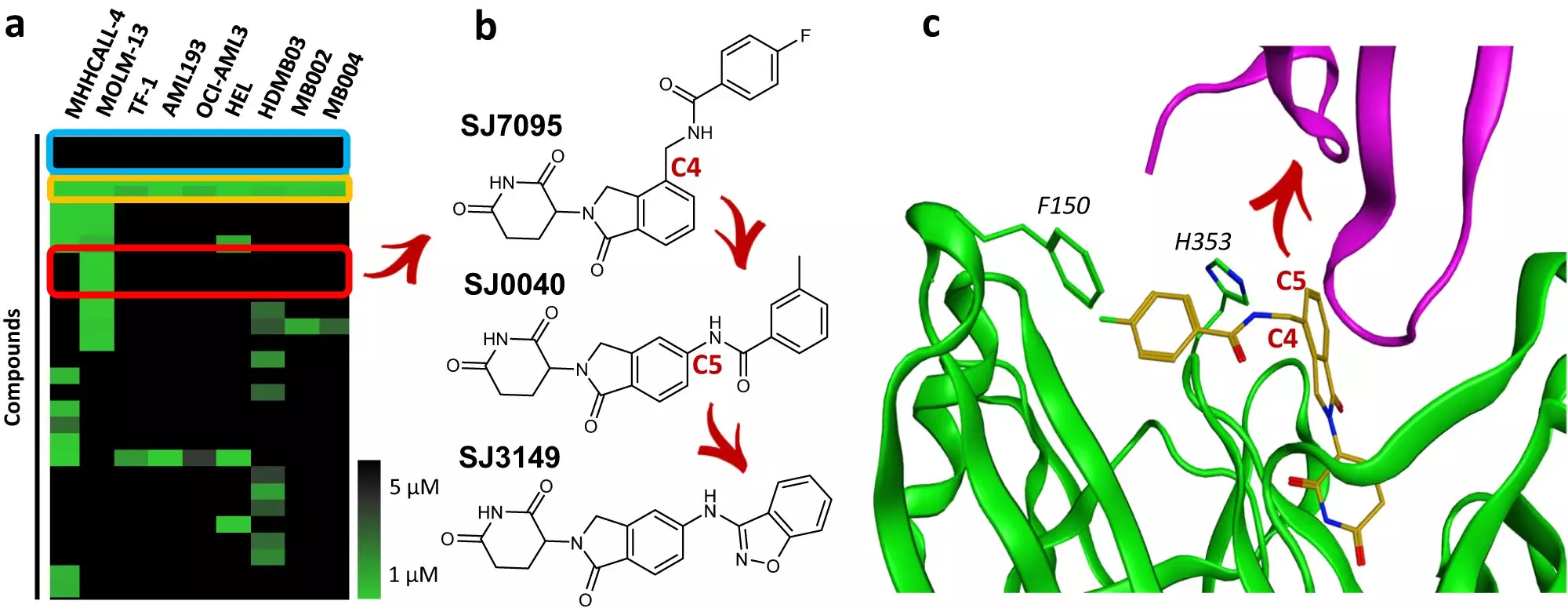The groundbreaking research conducted at St. Jude Children’s Research Hospital has unveiled an exciting development in the fight against cancer. Scientists at the institution have published their work on SJ3149, a compound with broad activity against various cancer types, particularly acute myeloid leukemia (AML). The study, published in the prestigious journal Nature Communications, highlights the discovery and potential therapeutic applications of this compound.
SJ3149 belongs to a new class of compounds known as molecular glues, which act by hijacking the cell’s natural protein recycling mechanism. Unlike traditional small molecule inhibitors, molecular glues have the ability to target previously undruggable proteins effectively. This promising approach has paved the way for researchers at St. Jude to develop a vast library of molecular glues, leading to the identification of SJ3149 as a potent and selective degrader of the cancer-related protein casein kinase 1 alpha (CK1α).
The research conducted at St. Jude demonstrated that SJ3149 showed impressive efficacy in both in vitro and in vivo cancer models. The molecule’s exceptional potency and minimal off-target effects distinguish it from similar compounds, positioning SJ3149 as a first-in-class CK1α degrader. In fact, SJ3149 exhibited such broad anti-cancer activity that it acquired the nickname “super-glue.”
Furthermore, SJ3149 exhibited a similar profile to a class of approved cancer drugs known as murine double minute 2 (MDM2) inhibitors. This parallel suggests that SJ3149 may possess clinical utility and serve as a viable therapeutic option. The potential to target previously difficult-to-treat proteins using molecular glues opens up new avenues for the development of innovative therapies against various types of cancer.
The success of the St. Jude approach in the discovery of SJ3149 bolsters the notion that identification and refinement of such molecules can accelerate the drug discovery process. By combining rational design, medicinal chemistry optimization, and the expertise of multiple research groups, the scientists at St. Jude were able to create a blueprint to conduct similar studies for other targets. This collaborative effort has not only unlocked the potential of SJ3149 but also holds promise for the future discovery of additional therapeutic options.
To gain a deeper understanding of SJ3149’s exceptional efficacy, the researchers at St. Jude crystallized the large complex of CK1α and SJ3149 bound to the cell’s protein ubiquitin ligase apparatus responsible for protein degradation. This innovative approach allowed them to elucidate how SJ3149 directly interacts with CK1α, connecting it to the enzyme responsible for cellular degradation. This structural and mechanistic insight provides a rationale for the compound’s high degradation efficacy, potentially paving the way for the rational design of molecular glues.
While SJ3149 is currently in the lead compound stage, the research holds great promise for the treatment of various pediatric cancers, including AML. The compound’s unique mode of action and encouraging results in patient-derived cancer cells make it an exciting prospect for future therapeutic options. The development of SJ3149 represents a major collaborative effort, combining the expertise of multiple research labs at St. Jude and external collaborators.
The emergence of molecular glues as a new paradigm in chemical biology marks an exciting breakthrough in the field. SJ3149 is just one example of how this innovative approach can lead to the discovery of novel therapies. The success of this research at St. Jude opens up new possibilities for the future development of molecular glues and the exploration of their therapeutic potential against various types of cancer.
The St. Jude team’s groundbreaking research on SJ3149 represents a significant step forward in the battle against cancer. Through the development of molecular glues and their innovative approach to drug discovery, they have identified a unique compound with broad activity against cancer types, particularly AML. The potency, selectivity, and potential clinical utility of SJ3149 make it an exciting prospect for the treatment of pediatric cancers. This research not only provides hope for patients but also serves as a blueprint for future studies in the field of chemical biology.


Leave a Reply